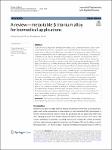Item Infomation
Full metadata record
| DC Field | Value | Language |
|---|---|---|
| dc.contributor.author | Pralhad, Pesode | - |
| dc.contributor.author | Shivprakash, Barve | - |
| dc.date.accessioned | 2023-04-18T03:20:27Z | - |
| dc.date.available | 2023-04-18T03:20:27Z | - |
| dc.date.issued | 2023 | - |
| dc.identifier.uri | https://link.springer.com/article/10.1186/s44147-023-00196-7 | - |
| dc.identifier.uri | https://dlib.phenikaa-uni.edu.vn/handle/PNK/8028 | - |
| dc.description | CC BY | vi |
| dc.description.abstract | Titanium and its alloys have already been widely used as implant materials due to their outstanding mechanical characteristics and biocompatibility. Notwithstanding this, researchers and businesses alike have continued to actively pursue superior alloys since there are still problems which need urgent consideration. One of these is a noteworthy difference in the implant material’s elastics modulus and that of natural bone, which result into an issue of stress shielding. With prolonged use Ti alloys releases dangerous ions. The Ti alloy surface has a low bioactivity, which prolongs the healing process. β-Ti alloys could be used as viable alternatives when creating dental implants. | vi |
| dc.language.iso | en | vi |
| dc.publisher | Springer | vi |
| dc.subject | β-Ti | vi |
| dc.subject | biomedical applications | vi |
| dc.title | A review—metastable β titanium alloy for biomedical applications | vi |
| dc.type | Book | vi |
| Appears in Collections | ||
| OER - Kỹ thuật điện; Điện tử - Viễn thông | ||
Files in This Item:

